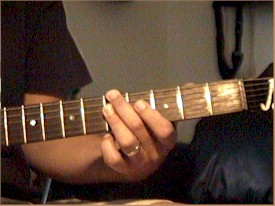Scroll through the lesson and click on notation/video/audio links to load the interactive players.
Please subscribe to get full access to all lessons for only $7.95/month PLUS 1 week free trial.

Riff Interactive lessons are
LESS expensive and
MORE interactive than alternatives!
More Info
|
|

Jam Sessions - Smooth Jazz
Style
Lesson 3 - Jam in
Am
Lyle:
Ready to do a little smooth jazz jammin' in Am!
ScottK: Yes,
I like the intro sample.
Lyle: Good, here's your jam track you'll need for
this lesson in Am:
Lyle:
Just two chords for this jam:
chord chart

Lyle: You can play Am to Bm, or I suggest Am7 to
Bm7 for a fuller sound. Here's how I suggest playing the rhythm riff:
Am7
chord

Lyle:
You can use your right hand fingers to play the rhythm riff or a pick. Either
way sounds good. Notice the fingering for the walk ups, the three fret chromatic
walk-ups. Your 2nd finger shifts up into position.
Lyle:
Here's another rhythm riff to try:
Lyle:
For rhythm riff 2, just lightly strum the chords back and forth, no bass note is
needed.
Lyle: Since you're jamming in Am, a simple scale
to use to help get a soulful sound is the A minor pentatonic scale. It's easy to
play and all the notes sound good. Listen to this tab riff of the scale so you
can hear how musical the scale can sound against the jam:
Lyle: A
fancier version of the minor pentatonic scale is the minor blues scale. It adds
the flatted 5th degree to the pentatonic scale to become the minor blues scale.
Lyle:
Because the two chords used in this jam (Am7 to Bm7) are the ii and iii chords
of the harmonized major scale, the A Dorian minor would be the mode of choice:
Lyle: If
you're just learning these scales, run through them like I do in the tabs and
video clips so you get a chance to hear how the whole scale sounds against the
jam. This is all part of ear training.
ScottK: There are some sliding between some of the notes
in the scale?
Lyle: The sliding, like in the A Dorian pattern above, is used for
effect. It's a technique used to make a scale run sound
musical.
Lyle: The solo in the lesson
sample is made from all these scales. It's also a simple solo made from little
riffs all put together. Here's is how all the riffs are played one by one.
Notice how the scales are used in each riff:
terry: is A
Dorian the same as A Dorian minor?
Lyle:
Yes.
Lyle: That's a fun riff to learn. You can loop
the TAB file and also slow it down if needed.
Lyle:
The 3rd measure has a tricky little riff in it. Your pick will pluck the 3rd
string and your 3rd/ring finger will pluck the 1st string.
Lyle:
The next riff from the solo uses the F#m7b5 arpeggio. This is the Locrian mode
in the key of G:
terry: Why key
of G?
Lyle: The two chords used in the progression, Am
and Bm, are the ii and iii chords related to the key of
G.
Lyle:
Try playing a G Maj scale over the jam track, you'll hear how each note
fits:
Lyle:
This solo riff 2 starts out using the F#m7b5 arpeggio, which is the arpeggio
from the seventh mode in the key of G major, the F# Locrian minor mode. The two
chords in this jam session are the ii and iii minor chords in the key of G
major. That's why the arpeggio from the 7th mode in the key of G major sounds
cool over the jam.
Lyle: You've got to understand the harmonized
major scale, then everything else falls into place. I'll work on teaching you
that in the near future. Just try to memorize these little "formulas" for now.
It will help when we put it all together.
Lyle:
For lessons about the harmonized major scale, check out Fretboard Theory
CD-ROM.
Lyle: The next riff uses octaves to create a
smooth sliding sound. I used the 5th string as my guide, playing notes from the
A Dorian minor:
Lyle:
Here's a harmony to that riff, this time using the 4th string as a guide. The
4th string has the notes from the A Dorian:
Lyle:
You may choose to strum the octave riffs or pluck them with your thumb and
finger. All the other strings are muted by relaxing your left hand.
Lyle:
Here's a way to play the first octave riff and the harmony all at the same time:
Lyle:
The next step would be to create a harmony of that riff:
Lyle:
Learn the riffs that you like and try them along with the scales I suggested
earlier and jam along with the jam track. Try them in any order you want.
Lyle:
That's all for this lesson and jam. You can purchase and download high quality
MP3 versions of these Smooth Jazz style jam tracks from my web site,
TheGuitar.net , just click on the Jam Tracks link for more
info.
|
<< load notation from left
|
|
<< load audio from left
|
<< load audio from left
|